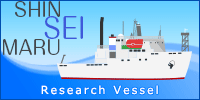The purpose of the research program is to clarify the impacts of the earthquake and subsequent tsunami on the marine ecosystems of the Tohoku coastal areas, highlight the restoration process of the ecosystems from a scientific aspect, and contribute to the reconstruction of the fishing industry in the Tohoku region.
First, we select typical coastal areas as model areas, determine the characteristics of the restoration process of the areas through an intensive study, and clarify the factors controlling the dynamics of the ecosystems in the Tohoku coastal areas. For this purpose, we perform continuous, long-term studies in the Otsuchi Bay, Onagawa Bay, and Sendai Bay areas, for which scientific data obtained before the earthquake exists.
The coastal areas have complex ecosystems, involving interactions between land and sea, between water masses and the benthos, and between the neritic region and the oceanic region. It is difficult to comprehend the mechanisms of variation within these ecosystems unless you understand these interactions; thus it is necessary to highlight the characteristics of the ecosystems. For example, the features of estuarine areas, seaweed beds, and tidal flats; the cycle of matter from an inner bay to an offing; and the variation in ecosystems from a neritic region to an oceanic region (from the surface layers to the seabed). We will construct models of these environmental and biological findings, which will incorporate land, coast, and ocean, to highlight the restoration process of the bioresources in all of the ecosystems.
Combining these two approaches, the research program, led by Tohoku University,
AORI, and JAMSTEC, will be promoted with the participation of researchers nationwide and with the
cooperation of people involved in the fishing industry.
Tohoku University will investigate the ecosystems within seaweed beds and tidal flats along
the southern part of the Sanriku coast, in particular in Onagawa Bay and Sendai Bay, to elucidate
the state of the fishery resources and to clarify the restoration process of the fishery resources.
AORI will establish a base in Otsuchi Bay, on the northern part of the Sanriku coast, and they will
identify the restoration process of the bioresources from the aspects of food chains and the
cycling of matter from neritic to oceanic regions. JAMSTEC will carry out debris mapping of the
bottom layer of the offing and conduct long-term monitoring of offing ecosystems, including the
dynamics of the bioresources and the accumulation of chemical substances, in order to understand
the restoration process of ecosystems damaged during the earthquake and subsequent tsunami.
Results obtained from the research program will be made available to not only people who are
related to fisheries and tourism services but also to local governments and the public, and,
furthermore, to researchers all over the world through databases that will be created and
symposiums that will be held.

The research program comprises 4 projects, which consist of 10 themes in all. Projects 1 to 3 will promote investigation and research and Project 4 will construct a base for sending out information conducive to the reconstruction of industries in the disaster-affected areas.
Links










